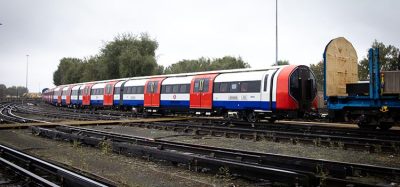Spotlight on Shields Depot, Glasgow
Posted: 21 July 2009 | | No comments yet
Rail travel has been growing in Scotland with more than 20% growth since 2004 and, as a result, government agency Transport Scotland is funding a major enhancement programme for the rail network in Scotland. As a part of this programme, 38 new Class 380 trains will be delivered between September 2010 and spring 2011, adding some 9,000 seats to the Scottish rail network at a cost of approximately £200 million.
Rail travel has been growing in Scotland with more than 20% growth since 2004 and, as a result, government agency Transport Scotland is funding a major enhancement programme for the rail network in Scotland. As a part of this programme, 38 new Class 380 trains will be delivered between September 2010 and spring 2011, adding some 9,000 seats to the Scottish rail network at a cost of approximately £200 million.
Rail travel has been growing in Scotland with more than 20% growth since 2004 and, as a result, government agency Transport Scotland is funding a major enhancement programme for the rail network in Scotland.
As a part of this programme, 38 new Class 380 trains will be delivered between September 2010 and spring 2011, adding some 9,000 seats to the Scottish rail network at a cost of approximately £200 million.
The new fleet signals a 40% uplift in numbers of Electric Multiple Units (EMUs) in Scotland; indeed it’s the biggest electric train order for Scotland in a decade.
The Class 380s will operate between Glasgow Central, Ayrshire and Inverclyde, serving routes to Ayr, Ardrossan, Largs, Wemyss Bay and Gourock. They will also operate to Glasgow Airport when the Glasgow Airport Rail Link (GARL) opens in 2013.
The trains are from the Siemens Desiro UK family, a well proven train in the UK with more than 100 million miles of service with operators such as South West Trains, London Midland, Heathrow Connect, and Trans Pennine Express, whose diesel Desiro Class 185 trains already operate into Scotland.
The units combine the proven systems of existing Desiros with a new 23m length bodyshell to provide additional capacity for the routes where they will operate – 6-car and 7-car trains will provide between 50 and 120 additional seats by comparison with the 6-car trains of 20m length carriages that they will replace. The Class 380 is the first 23m Electric Multiple Unit to be operated by ScotRail.
The new trains will enable not only capacity growth, but will also release for redeployment Class 318 and Class 334 fleets currently operating on Ayrshire and Inverclyde routes. These will be used to provide additional capacity on existing routes and to provide the fleet to operate the new Airdrie-Bathgate (A2B) route providing a fourth through route between Glasgow and Edinburgh.
Transport Scotland regards the new trains as crucial in its sustained programme of investment in the rail network – a programme that will reap significant benefits for the Scottish economy and the environment.
The agency is investing £24 million in depot enhancements, underlining its long-term vision for Scotland’s Railway. Its ‘fit for future purpose’ approach will not only ensure that the Class 380s are properly maintained but will also safeguard anticipated fleet and infrastructure expansion in future years in the most sustainable and cost effective way.
Shields Depot
Shields Depot has been selected as the home depot to stable and maintain the new Class 380s.
One of ScotRail’s four engineering depots in Scotland – and the only one dedicated to maintaining EMUs, Shields is currently responsible for maintaining Classes 314, 318, 320, 322 and 334. From September 2010, 38 Class 380s will be added to that list.
The depot, situated south west of Glasgow city centre and alongside the route from Glasgow to Ayrshire and Inverclyde, opened in 1967. The guest of honour was the then Transport Minister, Barbara Castle MP.
Fast forward to 2008, however, and it was clear to the project planning team that the existing facilities at Shields would be insufficient to handle the new Class 380 fleet in addition to their existing allocation.
Over the last year, plans have been formed to re-develop the site. The new depot will be fit for the 21st century and will make much better use of existing space.
Pride of place will go to a new 3-road maintenance shed, while a replacement wheel lathe building will be constructed towards the west end of the site to release space for the new facility.
The entrance area will be reconfigured to provide improved layout for car parking and other essential facilities. The fire training facility will be relocated.
Construction will take place entirely within the existing Shields site.
Siemens has been awarded the contract to upgrade the existing site, and has the experience to deliver. It has constructed rail depots in York, London, Southampton, Northampton and Manchester.
Siemens’ plans will considerably improve the appearance of the existing depot and surrounding area. A key consideration is to minimise any environmental impact and maximise energy efficiency with state-of-the-art lighting technologies and building materials.
Clough Smith Rail has been employed to design and build the new facilities based on its experience in carrying out similar schemes for Siemens Mobility throughout the UK. A specialist rail contractor, Clough Smith Rail has worked on some of the biggest and most complicated rail projects in the UK including the high-profile west coast route modernisation.
For the Shields Depot project, Clough Smith Rail is not only tasked with delivering the facilities on time and to budget, but also ensuring that the existing depot continues to function with as little impact on its day-to-day operations as possible. In order to achieve this, weekly meetings have been held and the order of works tailored to meet the aspirations of the depot staff.
Clear communication is crucial. Before construction began, Siemens – working with all partners – prepared a communications plan to ensure that stakeholders were briefed at an early stage. This included letters to lineside residents, community groups and local MPs and MSPs, as well as direct contact with local schools, emergency services and the media. A customer helpline was established via ScotRail’s customer contact centre.
The depot expansion is likely to create some 30 new permanent engineering and support roles.
A further 120 ScotRail train crew jobs will support the planned uplift in services across the west and central belt of Scotland.
In a novel interworking agreement, a Siemens team will be based at the depot to support the maintenance and servicing of the new fleet and manage spare parts supply.
The new-style depot will underpin the successful partnership approach to improving service delivery to the travelling public, and will ultimately ensure we deliver world class services.
Maintenance facility
Activities at the redeveloped Shields Road depot will cover the full range of train maintenance and associated services – such as toilet-emptying – as well as housing trains overnight. Offices for ScotRail and Siemens production support staff will also be included.
A new maintenance building will be constructed on the existing wheel lathe site at the east end of the site. Building will not start until the new wheel lathe is completed and commissioned.
It will have three ‘roads’ – including one designated for heavy maintenance and featuring synchronised lifting jacks and a bogie drop facility, provided by Mechan. This will facilitate the exchanging of bogies, undercar mounted equipment modules and wheel sets from units, as and when required, without the need to lift or split the train formation.
Wesurail will install a new Controlled Emission Toilet System (CET) to allow all fleets to have their toilets emptied in a hygienic and efficient manner.
In addition, a new Depot Protection System will be introduced, supplied by Zonegreen. Based on the Mechan Smart Depot Protection System, the new system will allow depot staff to safely move units around the sidings and the new facilities while knowing precisely the location of all staff in relation to units being stabled at the depot.
The overall design of the building will significantly improve ScotRail’s ability to deliver optimum levels of engineering maintenance for all its EMUs.
Sustainable approach
The arrival of the Siemens Desiro Class 380 will bring the very latest in sustainable rail technology to Scotland. There will be real benefits for passengers on the Ayrshire, Inverclyde and Renfrewshire routes through improved facilities, better accessibility and comfort.
Siemens Desiro trains have proven to be up to four times more reliable than the existing Scottish fleets. Featuring regenerative braking and low weight aluminium bodyshells, the trains are designed and manufactured with the protection of the environment in mind.
ScotRail drivers are trained in eco-driving techniques to enable them to operate trains with a driving style that reduces energy consumption, and the trains provide information to assist the drivers in this.
Wheel lathe
The existing wheel lathe at Shields dates from the 1980s when the original Atlas machine was replaced with a German-built Hegenscheidt version.
However, a new wheel lathe building with associated equipment is essential to allow the existing lathe site to be used for the new maintenance shed. In addition, more lathe capacity is needed to meet increased demand prompted by the larger fleet
The lathe – used to cut and maintain wheels to ensure they are perfectly circular – will service the entire ScotRail fleet. Supplied by Hegenscheidt it will feature twin cutting heads, allowing two wheels on axles to be prepared at the same time.
OUT NOW: The Definitive Guide to Rail’s Digital Future
The rail industry is undergoing a digital revolution, and you need to be ready. We have released our latest market report, “Track Insight: Digitalisation.”
This is not just another report; it’s your comprehensive guide to understanding and leveraging the profound technological shifts reshaping our industry. We move beyond the buzzwords to show you the tangible realities of AI, IoT, and advanced data analytics in rail.
Discover how to:
- Optimise operations and maintenance with real-time insights.
- Enhance passenger services through seamless, high-speed connectivity.
- Leverage technologies like LEO satellites to improve safety and efficiency.
Featuring expert analysis from leaders at Nomad Digital, Lucchini RS, Bentley Systems and more, this is a must-read for any rail professional.







